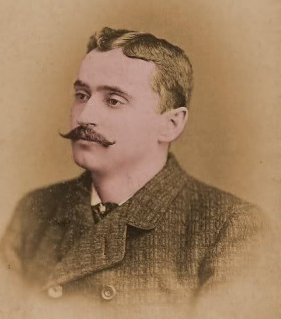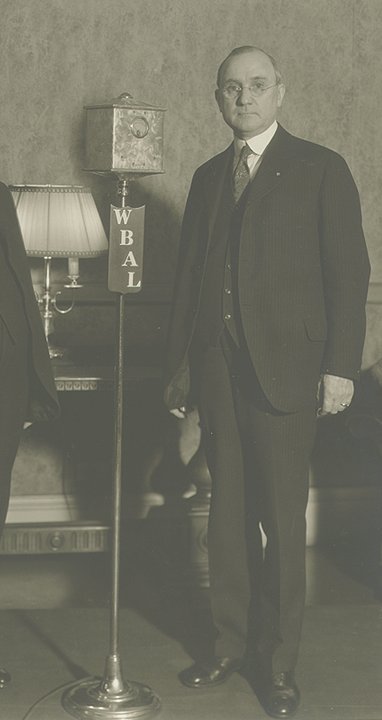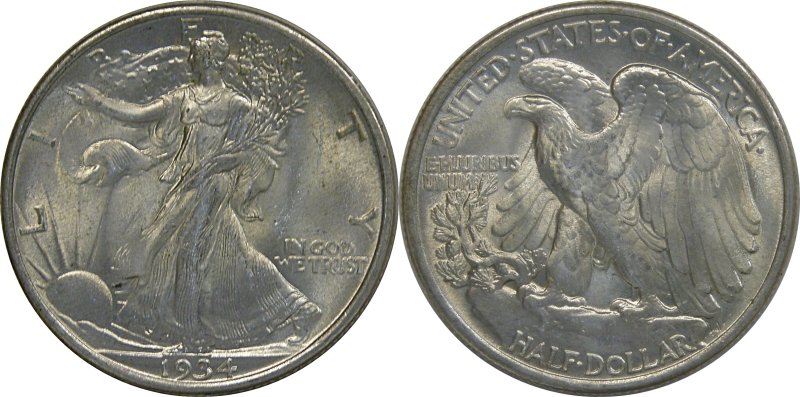 Edward Hugh (Ned) Hanlon | Mount Pleasant ParkGolf CourseMaryland's Tournament CourseEstd. June 30, 1934 | Charles Augustin (Gus) Hook |
 Edward Hugh (Ned) Hanlon | Mount Pleasant ParkGolf CourseMaryland's Tournament CourseEstd. June 30, 1934 | Charles Augustin (Gus) Hook |
 Howard W. Jackson in 1932
Howard W. Jackson in 1932
Mayor of Baltimore, 1923–27 and 1931–43
Prior to opening the golf course, it was necessary to set the greens fees. In the first week of June, 1934, the Park Board recommended to the mayor that a fee of either fifty cents or one dollar be charged. The mayor called for a public meeting at which time the various opinions could be heard and considered.
Most golfers proposed setting fees equal to those charged at nearby Clifton Park; fifty cents on weekends and holidays, and a quarter during the week. Others suggested that the higher rate of one dollar would tend to keep off the course those whom they called “dubs,” players who tore up courses and played slowly.
Henry S. Barrett, former head of the Public Parks Golf Association, stated that dubs would not necessarily be deterred by higher greens fees, but that any problems they caused could easily be remedied by “strict enforcement of the rules” and “the ordinary practice of golf etiquette.”
Assured by high authority that slow play and course damage could be so easily prevented, the mayor set the rate at fifty cents, anytime.
 Fifty cents in 1934 had the buying power of $8.70 in 2013 dollars. The melt value of the silver and copper in this coin in 2013 is $7.09.
A 1934 Walking Liberty Half Dollar sells for between $40 and $2,500, depending on condition and mint. Green fees in 2013 at the Mount range from $26 to $49.
Fifty cents in 1934 had the buying power of $8.70 in 2013 dollars. The melt value of the silver and copper in this coin in 2013 is $7.09.
A 1934 Walking Liberty Half Dollar sells for between $40 and $2,500, depending on condition and mint. Green fees in 2013 at the Mount range from $26 to $49.
Mount Pleasant Golf Course was officially opened by Mayor Howard W. Jackson at 1:00 p.m. on Saturday, June 30, 1934. Approximately 250 people attended the festivities. Frank J. Flynn, president of the Carroll Park Golf Club, performed the duty of master of ceremonies. J. Cookman Boyd, George Leroy Nichols, general superintendent of parks, Adam Kromm, and George M. Armor, members of the Park Board, were introduced, and each made brief remarks. Mayor Jackson delivered the keynote address.
Ned Hanlon was not present at the ceremony, and it is almost certain that Gus Hook was also absent. Mr. Armor and Mr. Kromm, members of the Park Board, were introduced. Had the president of the Board, Ned Hanlon, been in attendance, obviously he would have been introduced. Equally obviously, had Hook, the architect and the builder of the course, been present, he would have been acknowledged before the assembly. No mention of Gus Hook or Ned Hanlon was made in the newspaper accounts of the event. It is almost inconceivable that these two men, who had designed and built the course, would miss the official ceremony. Gus Hook had, by this time, joined Hillendale Country Club, thus giving up the chance to represent Baltimore in the national public links team championships. And Ned Hanlon was 76 years old. It would be interesting to know if these were the reasons they didn't attend, or if there were other reasons they stayed away.
Following the speeches, Mayor Jackson hit the first official [albeit ceremonial] drive from the first tee. It traveled not far. The Baltimore Sun published something like a poem that celebrated his feat:
Mayor Jackson is a mighty man with strong and sinewy hands,
Who makes a golf ball answer to executive commands.
The fact that fifty yards was all the soaring pellet flew
Did not disturb Hizzoner’s form—at least he followed through.
Perhaps it was love of good poetry that kept Hook and Hanlon from attending the Opening Day ceremonies.
The first foursome to start was composed of C. K. Oakley, president of the Clifton-Mount Pleasant Golf Association, and Joseph Beck, Harold Peterson, and William McLean, all members of the board of directors of that association.
The next group included Preston A. Pairo, president of the Forest Park Golf Club, J. L. Eckenrode, chairman of the board of governors, and Robert Lewis and James D. Shaw, members of the board.
Third came Henry S. Barrett [undoubtedly secure in his belief that play wouldn’t be slowed by dubs], John E. Cross, official Baltimore representative to the United States Golf Association, Emanuel A. Hyman, former president of the Public Parks Golf Association, and H. Cliff Shakespeare, former president of the Forest Park golf association.
Next to the tee came Robert Butler Gibson, president of the Carroll Park Golf Club, E. L. Plate, William Plate, and L. Emory Sauerwald, all members of Carroll Park’s board of directors.
The last official foursome, playing a better-ball match, pitted the team of Roger Peacock (who would also play in the 1953 Eastern Open), reigning MSGA Men’s Amateur champion, and Ernest L. Caldwell, the Baltimore City titleholder, against Buck Armacost [A golfer named John A. Armacost played in the 1939 Publinx at the Mount.] , a Forest Park ace, and Edward Leonard, the current Clifton Park club champion. Most of the crowd of 250 followed this foursome.
The match was halted after twelve holes due to heavy rain, with Mr. Peacock and Mr. Caldwell ahead 5-up.